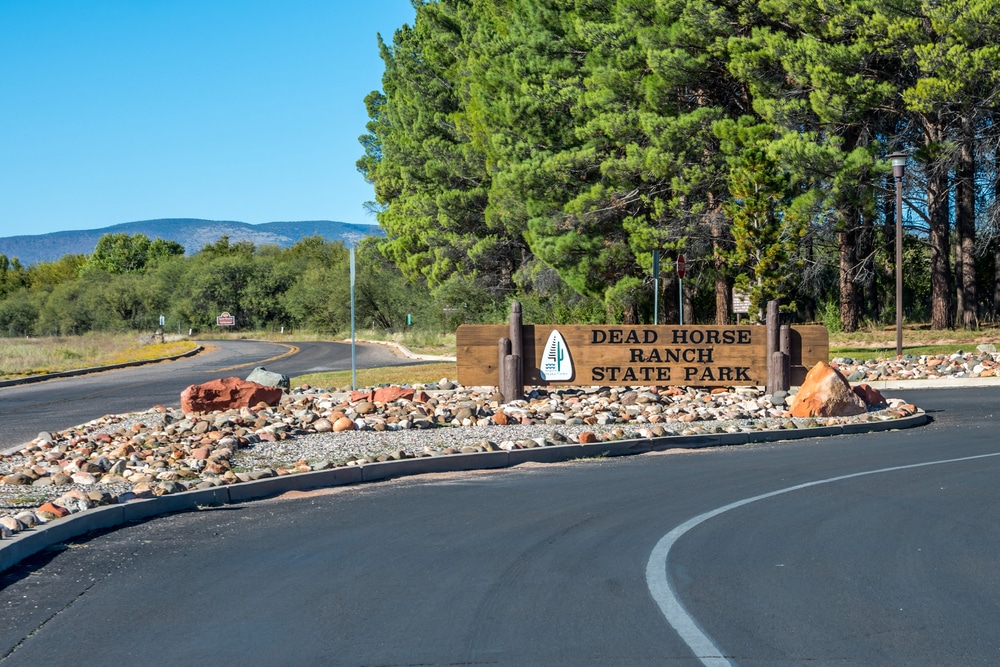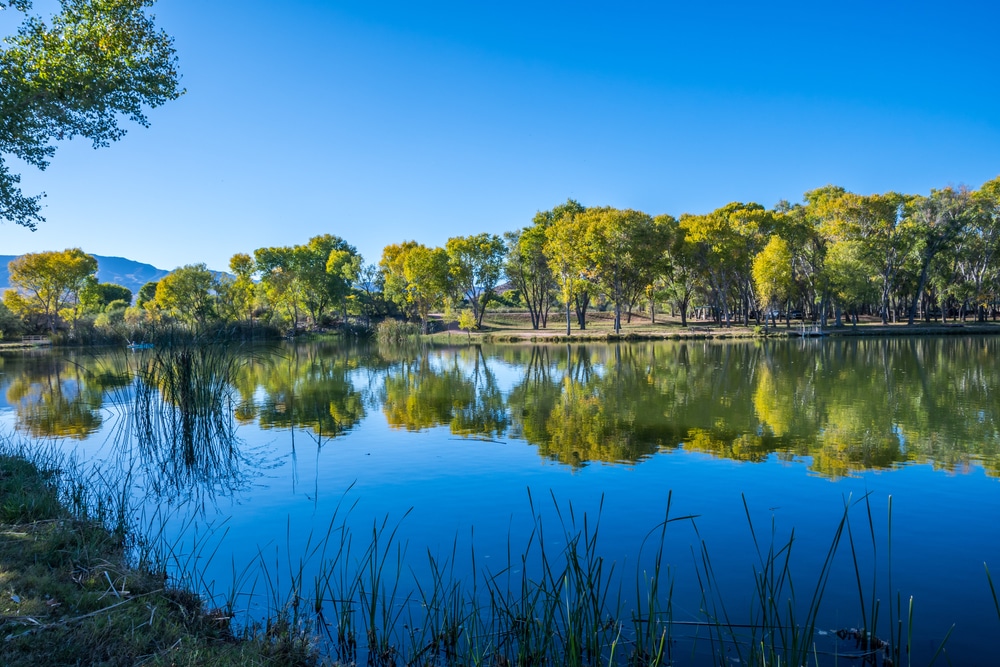Nestled in the heart of Arizona’s Verde Valley, Dead Horse Ranch State Park stands as a verdant oasis amid the high desert landscape. Located at coordinates 34.7689° N, 112.0236° W, this 423-acre park sits at an elevation of 3,300 feet along the banks of the Verde River, one of Arizona’s few perennial waterways. Just a stone’s throw from the historic town of Cottonwood and less than 20 miles from Sedona’s red rock country, the park offers visitors a perfect blend of natural beauty and recreational opportunities.
The park derives its unusual name from a memorable ranch viewing experience by the Ireys family in the 1940s. When searching for ranch property, the family came across a parcel with a dead horse lying on the land. Later, when asked which property they wished to purchase, the Ireys children responded, “the one with the dead horse.” The name stuck, and in 1973, when the Ireys sold the land to Arizona State Parks, they made one stipulation—that the park retain the Dead Horse Ranch name, preserving this quirky bit of local history.

Today, Dead Horse Ranch State Park represents one of the crown jewels in Arizona’s state park system, particularly valued for its riparian habitat—a rare and precious ecosystem in the arid Southwest. The park encompasses three lagoons, extensive cottonwood-willow forests, and access to the free-flowing Verde River, creating a haven for both wildlife and outdoor enthusiasts.
Visitors flock to Dead Horse Ranch for its exceptional bird watching opportunities, with over 150 species documented within the park’s boundaries. The diverse landscape offers outstanding hiking and equestrian trails, while the lagoons and river provide ample fishing, kayaking, and canoeing opportunities. With its extensive campground, cabin rentals, and proximity to the Verde Valley Wine Country, the park serves as an ideal base for exploring central Arizona’s natural and cultural attractions.

The park encompasses a significant portion of the Verde River Greenway, a protected riparian corridor with ecological importance. This lush riverside environment creates a striking contrast to the surrounding desert landscape, supporting diverse plant and animal communities. Interpretive trails explain the ecological significance of this rare desert riparian zone and its importance to regional wildlife populations.

The lagoons and Verde River provide excellent paddling opportunities. The calm waters of the lagoons are perfect for beginners and families, while the gently flowing Verde River offers a more adventurous experience with wildlife viewing opportunities. Several designated launch points provide easy water access, and the park occasionally hosts guided paddling tours focusing on river ecology and riparian environments.

Dead Horse Ranch State Park features three lagoons stocked with rainbow trout, largemouth bass, bluegill, and catfish. These easily accessible fishing ponds offer excellent opportunities for anglers of all skill levels, with shoreline access around the entire perimeter. The Verde River section within the park provides additional stream fishing experiences with native species. The Arizona Game and Fish Department regularly stocks the lagoons, making them particularly productive during cooler months.

Over 20 miles of well-maintained trails wind through the park’s riparian areas and up into the surrounding hills. The Hickey Ditch Trail follows an historic irrigation channel with abundant bird life, while the more challenging Thumper Trail climbs to panoramic vistas of the Verde Valley and distant mountains. The Lime Kiln Trail connects to Coconino National Forest lands, allowing for extended backpacking adventures beyond park boundaries.

The diverse habitats within Dead Horse Ranch support abundant wildlife including mule deer, javelina, beaver, river otters, and countless bird species. Dawn and dusk offer the best viewing opportunities, particularly along the riparian corridor where animals come to drink. The River Day Use Area provides wildlife viewing platforms overlooking the Verde River, and interpretive signage helps visitors identify common species.

The park offers diverse camping options with 127 developed sites accommodating tents and RVs, including both standard and full-hookup sites. Each campsite features a fire ring, picnic table, and nearby restroom facilities with hot showers. For those seeking a more rustic experience, the park maintains river-access cabins and group camping areas. The campgrounds are thoughtfully arranged to maximize privacy while offering shade from mature cottonwood trees.

Multiple day-use areas throughout the park offer picnic tables, grills, and shade ramadas. The West Lagoon day-use area provides particularly scenic settings with tables situated among mature cottonwood trees offering natural shade during summer months. Group ramadas with larger capacity are available by reservation for family gatherings, reunions, and special events.
Dead Horse Ranch State Park offers a wealth of recreational opportunities that vary with the seasons, allowing visitors to experience the full range of the park’s natural beauty throughout the year.
Water activities center around the park’s three lagoons and the Verde River. The lagoons provide calm waters ideal for beginner paddlers, with kayak and canoe rentals available seasonally at the park store. The Verde River offers a more adventurous paddling experience, with several access points within the park. During spring runoff (typically March through May), the river flow increases to levels suitable for inflatable kayaks and small rafts. Summer sees gentler flows perfect for tubing and casual paddling trips. Swimming is not officially designated in the park but is permitted in the Verde River at visitors’ own risk—the lagoons are reserved for fishing and non-contact water recreation.
Fishing ranks among the most popular activities at Dead Horse Ranch, with opportunities available year-round. The lagoons are stocked regularly with rainbow trout from November through March, transitioning to channel catfish and bluegill in warmer months. The Verde River harbors smallmouth bass, catfish, and the occasional largemouth bass. Particularly productive fishing spots include the accessible fishing pier on the largest lagoon and the deep pools downstream from the park’s river access points. Arizona fishing regulations apply, and all anglers 10 years and older must possess a valid Arizona fishing license, available online through Arizona Game and Fish Department or at local sporting goods stores in Cottonwood.
The park maintains approximately 20 miles of multi-use trails that showcase the diverse ecosystems. The Lagoon Trail (1.5 miles, easy) circles the park’s three lagoons with minimal elevation change, making it accessible for most visitors. The more challenging Lime Kiln Trail (15 miles, moderate to difficult) connects Dead Horse Ranch to Red Rock State Park near Sedona, offering spectacular views of the Verde Valley along the route. The Jail Trail (2.4 miles, easy) follows the Verde River and links the park to Old Town Cottonwood. For equestrians, the Raptor Hill Trail (2.5 miles, moderate) accommodates horses and offers panoramic vistas of the surrounding mountains.
Photography enthusiasts find endless subjects throughout the seasons—spring wildflowers along the river, summer thunderstorms building over the mountains, fall colors in the cottonwood gallery, and winter frost outlining bare branches. Particularly photogenic locations include the Verde River viewpoint near the east day-use area and the birding trail that winds through dense riverside vegetation.
When darkness falls, Dead Horse Ranch becomes a premier stargazing destination. The relatively high elevation and distance from major urban centers create excellent conditions for viewing the night sky. The area near the group camping area offers an open meadow perfect for setting up telescopes or simply spreading a blanket for naked-eye astronomy. During summer months, park rangers occasionally offer guided stargazing programs highlighting seasonal constellations and celestial objects.
For mountain bikers, the Raptor Hill and Thumper Trails offer moderately technical riding with some rocky sections and elevation changes. The park connects to the extensive Coconino National Forest trail system, allowing for longer, more challenging rides.

| Category | Details |
|---|---|
| Location | Cottonwood, Arizona, USA (Verde Valley) |
| Area | 423 acres (171 hectares) |
| Elevation | 3,300 feet (1,006 m) |
| Established | 1977 |
| Previous Use | Working ranch purchased by the Ireys family in 1950 |
| Name Origin | When the Ireys family was looking at ranches, their children preferred this one because of a dead horse lying near the property. They referred to it as “the dead horse ranch,” and the name stuck. |
| Water Features | Verde River access, three fishing lagoons |
| Camping | 100+ campsites, cabins, group camping areas |
| Trails | Over 20 miles (32 km) of multi-use trails |
| Popular Trails | Lime Kiln Trail, Verde River Greenway Trail, Deadhorse Ranch Trail |
| Recreation | Fishing, hiking, mountain biking, horseback riding, canoeing, kayaking, bird watching |
| Wildlife | Over 100 species of birds, river otters, beavers, deer, coyotes, javelina |
| Plant Life | Cottonwood trees, willows, mesquite, various riparian and desert vegetation |
| Annual Events | Verde Valley Birding & Nature Festival |
| Connected Areas | Connected to the Verde River Greenway State Natural Area |
| Special Features | Historic Lime Kiln, riparian habitat preservation area |
| Best Time to Visit | Spring and fall for moderate temperatures |
| Distance from Phoenix | Approximately 100 miles (160 km) |
| Management | Arizona State Parks & Trails |
| Nearby Attractions | Tuzigoot National Monument, Jerome, Sedona |
Dead Horse Ranch State Park’s most prominent natural feature is its extensive riparian zone along the Verde River, one of Arizona’s last free-flowing rivers. This 190-mile waterway originates near Paulden in central Arizona and flows south until joining the Salt River east of Phoenix. Within the park, the Verde River meanders through stands of cottonwood and willow trees, creating a lush corridor that contrasts dramatically with the surrounding semi-arid landscape.
In addition to the river, the park features three human-made lagoons that total approximately 15 acres of surface water. These lagoons, ranging in depth from 8 to 12 feet, are regularly stocked with fish and provide critical habitat for waterfowl and other aquatic species. The largest lagoon offers approximately 2 miles of accessible shoreline, perfect for fishing or simply enjoying the reflections of the surrounding mountains on calm mornings.
The broader landscape surrounding the park represents a transition zone between the Colorado Plateau and the Basin and Range provinces. This geographical positioning creates a diverse terrain with an intriguing mix of plant communities. The elevation gradient within and around the park—ranging from approximately 3,300 feet at the riverside to over 3,600 feet in the higher reaches—contributes to this ecological diversity.
Geologically, the area features Tertiary and Quaternary period deposits, with exposed volcanic rocks and sedimentary layers that tell the story of millions of years of geological processes. The Verde Formation, consisting of limestone, mudstone, and evaporites deposited in ancient Lake Verde, underlies much of the area. This formation is visible in places where erosion has cut through younger layers, revealing the limestone cliffs that characterize portions of the Verde Valley.
The park sits within the Verde River watershed, which drains approximately 6,600 square miles of central Arizona. This watershed provides crucial habitat for numerous species and serves as an important wildlife corridor connecting the higher elevation forests to the north with desert ecosystems to the south. The health of this watershed directly impacts not only the park’s ecosystems but also communities downstream that depend on the Verde River for water supplies.
Seasonal changes transform the park dramatically throughout the year. Spring brings wildflower blooms and increased river flow from snowmelt in the higher elevations. Summer monsoons (typically July through September) can cause rapid fluctuations in river levels and temporarily increase water clarity in the lagoons. Fall reveals spectacular colors as the cottonwoods and other deciduous trees turn brilliant yellow and gold, while winter offers a quieter, more contemplative landscape with occasional dusting of snow.
Dead Horse Ranch State Park showcases an impressive array of plant life typical of riparian zones in the Southwest. The dominant trees along the Verde River include Fremont cottonwood (Populus fremontii), Goodding’s willow (Salix gooddingii), and velvet ash (Fraxinus velutina). These species form a canopy that can reach heights of 80 feet, creating cool, shaded corridors even during the hottest summer months. The understory features seepwillow (Baccharis salicifolia), coyote willow (Salix exigua), and various native grasses.
Moving away from the immediate riverbank, visitors encounter mesquite bosques with velvet mesquite (Prosopis velutina) and catclaw acacia (Acacia greggii). The drier upland areas support desert-adapted species such as crucifixion thorn (Canotia holacantha), several varieties of prickly pear cactus (Opuntia spp.), and drought-resistant shrubs like creosote bush (Larrea tridentata) and snakeweed (Gutierrezia sarothrae).
Seasonal wildflower displays vary in intensity depending on winter rainfall but typically include desert marigold (Baileya multiradiata), globemallow (Sphaeralcea ambigua), and several species of lupine. Invasive species like tamarisk (Tamarix spp.) and Russian olive (Elaeagnus angustifolia) have been targets of ongoing restoration efforts to protect the native plant communities.
The park’s diverse habitats support an equally impressive variety of wildlife. Mammals commonly spotted include mule deer, javelina (collared peccary), raccoons, gray foxes, and the occasional bobcat. More secretive residents include ringtail cats, skunks, and several bat species that roost in trees along the river.
For bird enthusiasts, Dead Horse Ranch represents one of Arizona’s premier destinations. The park has documented over 150 bird species, with notable year-round residents including great blue herons, belted kingfishers, and several hawk species. Spring and fall migrations bring colorful warblers, tanagers, and flycatchers, while winter attracts numerous duck species to the lagoons. Birdwatchers specifically seek out the elegant vermilion flycatcher, the striking summer tanager, and the rare yellow-billed cuckoo, which nests in the dense riparian forest during summer months.
The aquatic habitats support numerous amphibians and reptiles, including the Arizona tree frog, Woodhouse’s toad, and several turtle species. Reptile enthusiasts might spot western whiptail lizards, desert spiny lizards, and occasionally gopher snakes or western diamondback rattlesnakes (visitors should always maintain a respectful distance from any snake).
The park’s waters host various fish species, both native and introduced. The Verde River contains smallmouth bass, sunfish, and catfish, while the lagoons are regularly stocked with rainbow trout (typically from November through March) and channel catfish (during warmer months).
Seasonal ecological changes are particularly dramatic at Dead Horse Ranch. Spring triggers nesting activity for numerous bird species, with males establishing territories through song. Summer monsoons bring explosive growth in vegetation and increased activity among amphibians. Fall migration sees the departure of summer visitors like yellow warblers and the arrival of winter residents such as ruby-crowned kinglets. Winter offers quieter wildlife viewing, but the reduced foliage improves visibility for spotting year-round residents.
Dead Horse Ranch State Park boasts one of Arizona’s most extensive and well-maintained camping facilities, with options to suit a wide range of preferences and needs. The main campground consists of 127 sites distributed across three loops, each offering slightly different experiences and amenities.
The Cottonwood Campground (Loop A) features 52 sites with electric (30/50-amp) and water hookups, suitable for RVs up to 65 feet in length. These sites include fire rings, picnic tables, and access to nearby restrooms with hot showers. The Mesquite Campground (Loop B) offers 47 similar sites with the same amenities but in a slightly more open setting with views toward the surrounding mountains. The Quail Campground (Loop C) provides 28 non-hookup sites designed primarily for tent campers or smaller RVs, offering more privacy and natural surroundings while still maintaining proximity to modern restroom facilities.
For those seeking a more primitive experience, the park maintains a separate horse camp with 12 sites specifically designed for equestrian use. These sites include steel corrals, water troughs, and access to equestrian trails. Additionally, the park offers eight riverside camping sites that provide a more secluded experience along the Verde River—these sites have no hookups and require a short walk from the parking area, but reward campers with intimate river access and increased wildlife viewing opportunities.
For visitors preferring solid walls, Dead Horse Ranch maintains eight one-room cabins that sleep up to four people each. These climate-controlled cabins feature electricity, lights, and an outdoor living area with fire ring, picnic table, and electricity. Each cabin is furnished with one full-sized bed and one bunk bed, requiring guests to bring their own bedding. While the cabins don’t include bathrooms or kitchens, they’re situated near clean restroom facilities with hot showers. The cabins’ positioning on a small rise provides excellent views of the Verde Valley and the distant mountains.
All camping options at Dead Horse Ranch require reservations, which can be made up to one year in advance through the Arizona State Parks reservation system online or by phone. Campsites range from $25-$35 per night depending on amenities, while cabins cost $65-$95 per night depending on the season. During peak seasons (spring and fall), weekends often book months in advance, though midweek availability tends to be better.
For those unable to secure in-park accommodations, the nearby town of Cottonwood (less than 1 mile from the park entrance) offers numerous lodging options including hotels, motels, bed and breakfasts, and Airbnb rentals. The Verde Valley region also features several private campgrounds and RV parks within a 15-minute drive of Dead Horse Ranch.
Camping regulations include a 14-consecutive-day stay limit, quiet hours from 9 PM to 8 AM, and restrictions on collecting firewood within the park (firewood bundles are available for purchase at the park store). Each campsite is limited to a maximum of six people, two vehicles, and two tents. Generator use is restricted to the hours of 8 AM to 8 PM.
For the most comfortable camping experience, visitors should consider the seasonal variations that affect the park. Summer campers should select sites with afternoon shade (the Cottonwood loop offers the best tree cover), while winter visitors might prefer sites with morning sun exposure. The cabins, with their climate control, offer the most consistent comfort regardless of season.
Dead Horse Ranch State Park operates 365 days a year, with the entrance station staffed from 8 AM to 5 PM. Visitors can enter earlier or later through the automated fee station. Day-use areas close at 10 PM, though overnight campers may return to the campground at any hour.
Entrance fees are $7 per vehicle (up to four adults) for day use, with individual/bicycle entry at $3 per person. Arizona State Parks offers an annual pass for $75 that provides day-use access to all state parks, representing significant savings for frequent visitors. America the Beautiful federal passes are not accepted for entry fee discounts.
The park experiences distinct visitation patterns throughout the year. Spring (March through May) brings the highest visitor numbers, with pleasant temperatures and flowering vegetation making this the ideal season for most activities. Summer (June through September) visitation decreases during peak daytime heat but remains steady for morning activities and water recreation. Fall (October through November) sees another visitation spike as temperatures moderate and foliage colors change. Winter (December through February) offers the most solitude, though the park remains popular with birders and anglers targeting the trout-stocked lagoons.
Weather considerations vary dramatically by season. Spring typically features daytime highs of 70-85°F and overnight lows of 40-50°F, with occasional wind events. Summer brings daytime temperatures of 90-105°F and overnight lows of 60-70°F, with monsoon thunderstorms possible in afternoons (July through September). Fall transitions quickly from summer heat to cooler conditions, with daytime temperatures of 65-85°F and overnight lows of 35-50°F. Winter can be surprisingly cold, with daytime highs of 50-65°F and overnight lows sometimes dropping below freezing; occasional snow is possible though rarely accumulates significantly.
Accessibility features include paved paths connecting the main facilities, an accessible fishing dock at the largest lagoon, four ADA-compliant camping sites, and one ADA-compliant cabin. The Visitor Center features ramps, wide doorways, and accessible restrooms. Several picnic areas include ramadas with concrete pads suitable for wheelchair access. The park recently added a beach wheelchair that can be reserved in advance for use along the lagoon shores.
Pets are welcome throughout most of the park but must remain on leashes no longer than six feet at all times. Pet owners must clean up after their animals, and pets may not be left unattended at campsites. Pets are prohibited inside park buildings except for service animals.
Cell phone coverage is generally reliable throughout the park, with Verizon and AT&T providing the strongest signals. Free Wi-Fi is available at the Visitor Center, though the connection can be slow during peak usage times. The nearby town of Cottonwood offers numerous locations with reliable internet access, including the public library and several coffee shops.
For visitors with specific medical needs, the Verde Valley Medical Center is located approximately 2 miles from the park entrance, offering 24-hour emergency services. Several pharmacies operate in Cottonwood with typical business hours.
The hub of visitor services at Dead Horse Ranch State Park is the Visitor Center, located just inside the main entrance. This facility operates daily from 8 AM to 5 PM and houses an information desk staffed by knowledgeable park rangers and volunteers. Here, visitors can obtain trail maps, wildlife checklists, and information about current park conditions and programs. The center features interpretive exhibits highlighting the natural and cultural history of the Verde Valley, including displays on riparian ecosystems, local wildlife, and the mining history that shaped the region. A small gift shop offers field guides, educational materials, local crafts, and basic camping supplies.
Restroom facilities are strategically placed throughout the park, with the most developed facilities in the campground loops. These include flush toilets, sinks with running water, and hot showers (free for campers, coin-operated for day visitors). Additional restrooms are located at the Visitor Center, the lagoon day-use area, and the group ramada complex. Portable toilets supplement these permanent facilities during peak visitation periods at the river access points and trailheads.
The park maintains several day-use areas designed for picnicking and relaxation. The main picnic area near the lagoons features 15 ramadas equipped with tables, grills, and nearby water spigots. Eight of these ramadas can be reserved for groups ($15-$25 depending on size), while the remainder are available first-come, first-served. The Eagle View Group Area accommodates larger gatherings of up to 150 people (reservation required, $100-$150 depending on group size) and includes multiple tables, large grills, electrical outlets, and a serving counter.
For water recreation, the park provides two concrete boat ramps accessing the lagoons, suitable for hand-launched watercraft (electric motors only, no gas engines permitted). The Verde River can be accessed via three developed entry points with parking areas and short trails leading to the water’s edge. While no formal marina exists, the lagoon day-use area offers seasonal kayak and canoe rentals ($15-$25 hourly, life vests included).
Families with children particularly appreciate the recently renovated playground near the Quail Campground. This nature-themed play area features equipment suitable for children aged 2-12, with shade structures, benches for supervising adults, and a nearby water fountain. The playground surface consists of engineered wood fiber that meets accessibility guidelines while providing safe cushioning.
The park store, located adjacent to the Visitor Center, offers camping essentials, ice, firewood, basic groceries, and fishing supplies. Operating hours mirror those of the Visitor Center, with extended evening hours (until 7 PM) during summer months. While the store’s inventory is limited, comprehensive shopping is available in Cottonwood just one mile from the park entrance.
For specialized recreation, Dead Horse Ranch maintains a volleyball court near the group ramada area and a horseshoe pit adjacent to the Cottonwood Campground. Mountain bikers can utilize the bike repair station near the trailhead parking lot, equipped with basic tools and an air pump.
Notably, the park has installed solar-powered charging stations at the Visitor Center and near the lagoon day-use area, allowing visitors to charge mobile devices while enjoying outdoor activities. These stations feature multiple USB ports and standard outlets, though usage is limited to 30 minutes during busy periods.
Sanitation facilities include numerous trash and recycling stations throughout the park, with separate recycling for aluminum, plastic, and paper. A dump station for RVs is located near the campground entrance, available to registered campers at no additional charge (non-registered visitors may use the facility for a $15 fee).
The strategic location of Dead Horse Ranch State Park makes it an ideal base for exploring the diverse attractions of Arizona’s Verde Valley region. Within a 30-minute drive, visitors can access a remarkable variety of natural, cultural, and recreational destinations that complement the park experience.
Just 10 miles north in Jerome, the Jerome State Historic Park preserves the Douglas Mansion, offering insight into the area’s mining history with exhibits on the billion-dollar copper mining operations that once dominated the region. This former “wickedest town in the West” now thrives as an artist colony and tourist destination, with galleries, shops, and restaurants occupying historic buildings that cling dramatically to the mountainside.
For wine enthusiasts, the Verde Valley Wine Trail connects more than a dozen wineries and tasting rooms within a 15-mile radius of the park. Particularly notable are Page Springs Cellars (10 miles away), featuring riverside picnic areas adjacent to their vineyards, and the tasting rooms in Old Town Cottonwood, within walking distance of the park via the Jail Trail.
Nature lovers will appreciate Tuzigoot National Monument (3 miles from the park), where a 110-room pueblo crowns a limestone ridge, providing insight into the ancient Sinagua civilization that flourished in the Verde Valley between 1100 and 1425 CE. Nearby, Montezuma Castle National Monument (18 miles away) preserves one of the best-preserved cliff dwellings in North America, built into a recess in a limestone cliff 90 feet above the valley floor.
The spectacular red rock formations of Sedona lie just 19 miles north of the park, offering world-class hiking, mountain biking, and jeep tours. Red Rock State Park provides a more structured introduction to this landscape through interpretive programs and well-maintained trails along Oak Creek.
For more urban amenities, the historic Old Town district of Cottonwood borders the park’s eastern boundary. This revitalized area features locally-owned restaurants, breweries, antique shops, and the Old Town Center for the Arts, which hosts regular performances ranging from classical music to folk and jazz.
Families particularly enjoy the Verde Canyon Railroad (12 miles away in Clarkdale), offering a four-hour scenic train ride through a stunning canyon accessible only by rail. The adjacent Arizona Copper Art Museum displays the world’s largest collection of copper art, honoring the material that drove the region’s early development.
Outdoor adventurers can access the extensive trail networks of Coconino National Forest via several trailheads within a 15-minute drive of the park. Parsons Trail, leading to perennial springs and pools in Sycamore Canyon, offers a particularly rewarding day hike with numerous opportunities for wildlife viewing.
Local services catering to park visitors include Cottonwood’s full-service grocery stores (Safeway, Food City), outdoor retailer Verde Valley Outdoor (specializing in hiking and river equipment), and the Verde Valley Farmers Market (Saturdays, May through October). For emergency supplies, Cottonwood’s Ace Hardware and Walmart Supercenter both operate within 3 miles of the park entrance.
Dead Horse Ranch State Park stands as a model for conservation efforts in Arizona’s riparian areas, which represent less than 0.5% of the state’s land area yet support over 80% of its wildlife species. The park actively participates in the Verde River Greenway State Natural Area project, a collaborative effort to protect a 30-mile stretch of the Verde River riparian corridor.
Current conservation initiatives within the park focus on invasive species management, particularly the control of tamarisk (salt cedar) and Russian olive trees that displace native vegetation and alter the natural habitat structure. Park staff and volunteers regularly conduct removal operations followed by replanting with native cottonwoods and willows. These efforts have successfully restored several acres of riverside habitat, resulting in measurable increases in bird diversity in treated areas.
Water quality monitoring represents another critical conservation activity at Dead Horse Ranch. Staff conduct regular testing of both the Verde River and the lagoons, providing early detection of potential issues from upstream sources. This data contributes to broader watershed protection efforts coordinated through the Verde Watershed Restoration Coalition.
Visitors play an essential role in these conservation efforts through responsible recreation practices. The park emphasizes Leave No Trace principles, asking visitors to stay on designated trails, pack out all trash, minimize water usage, and observe wildlife from a respectful distance. Interpretive signage throughout the park educates visitors about the fragility of riparian ecosystems and how individual actions impact these environments.
For those wishing to take a more active role, the park offers multiple volunteer opportunities throughout the year. The Verde River Day (held annually on the last Saturday in September) engages hundreds of community members in river cleanup, native plant restoration, and citizen science activities. The park’s Adopt-a-Trail program allows individuals or groups to maintain specific trail sections, while the River Rangers volunteer program trains participants to conduct visitor education and basic monitoring along the Verde River.
Educational programs further enhance the park’s conservation mission. During peak seasons (March-May and September-November), rangers offer weekly interpretive talks covering topics such as riparian ecology, bird identification, and regional geology. The Junior Ranger program engages younger visitors through activity booklets that promote environmental awareness and stewardship ethics. School groups can participate in customized field trips aligned with Arizona science education standards, focusing on watershed ecology and environmental conservation.
The park collaborates with several conservation organizations, including the Friends of the Verde River, The Nature Conservancy, and Northern Arizona Audubon Society. These partnerships have facilitated habitat improvement projects, wildlife surveys, and community education initiatives that extend the park’s conservation impact throughout the Verde Valley.
Looking toward the future, Dead Horse Ranch State Park has implemented a Climate Change Adaptation Plan that addresses potential impacts to the park’s ecosystems. Strategies include establishing climate-resilient plant communities, enhancing wildlife corridors to facilitate species migration, and developing water conservation measures to address projected decreases in Verde River flows.
Through these multifaceted approaches to conservation and stewardship, Dead Horse Ranch State Park works to ensure that its unique natural resources remain vibrant and accessible for generations to come, while simultaneously serving as a living laboratory for sustainable management of Arizona’s precious riparian habitats.
Dead Horse Ranch State Park occupies land with a rich cultural history spanning thousands of years. Archaeological evidence indicates human presence in the Verde Valley dating back at least 10,000 years, with Paleo-Indian hunter-gatherers drawn to the reliable water source and abundant wildlife of the Verde River.
Between approximately 600 CE and 1400 CE, the Sinagua people established permanent settlements throughout the Verde Valley, including several sites within or adjacent to current park boundaries. These agriculturalists developed sophisticated irrigation systems to channel Verde River water to their fields of corn, beans, and squash. The nearby Tuzigoot pueblo and Honyaki pit houses represent visible reminders of this cultural period.
The park honors this indigenous heritage through interpretive programs developed in consultation with affiliated tribes, particularly the Yavapai-Apache Nation, whose reservation is located just a few miles from the park. The Visitor Center displays feature traditional tools, basketry, and agricultural implements alongside explanations of their cultural significance.
European American settlement of the area began in the 1860s, initially focused on mining and later transitioning to ranching and agriculture. The park’s name derives from its history as a working cattle ranch, purchased by the Ireys family in 1950. When Arizona State Parks acquired the property in 1973, at the family’s request, the colorful name was retained along with the ranch’s brand—a cattle skull over crossed horseshoes—which now serves as the park’s official logo.
Several historic structures remain within the park, including the original ranch house (now used for administrative offices) and a barn dating to the 1920s that has been repurposed as a maintenance facility. The Jail Trail connecting the park to Old Town Cottonwood follows the route used to transport prisoners between the former jail and work details along the river in the early 20th century.
The Verde Valley’s broader historical context includes its development as an agricultural center, with extensive vineyards established by Italian immigrants in the late 19th century. This viticultural heritage has experienced a renaissance in recent decades with the emergence of the Verde Valley as Arizona’s premier wine region, complementing the park’s natural attractions with cultural tourism opportunities.
Throughout the year, Dead Horse Ranch hosts events celebrating this diverse cultural heritage. The Verde River Day festival showcases traditional ecological knowledge alongside contemporary conservation practices. The Old-Time Ranch Days event (held each April) features demonstrations of historical ranching skills, western music, and Dutch oven cooking. During Native American Heritage Month in November, the park partners with the Yavapai-Apache Nation to offer programs on indigenous relationships with the Verde River ecosystem.
For visitors interested in exploring this cultural landscape further, the park offers a self-guided Heritage Trail with interpretive signage highlighting key historical sites and explaining how human interactions with the land have evolved over millennia. The park library, available for browsing during Visitor Center hours, contains volumes on local history, archaeology, and cultural practices associated with the Verde Valley.
By preserving and interpreting this multilayered cultural heritage, Dead Horse Ranch State Park provides visitors with a deeper understanding of human connections to this landscape—connections that continue to evolve through contemporary conservation efforts and recreational enjoyment of this special place along the Verde River.
During monsoon season (July-September), be prepared for afternoon thunderstorms and possible flash flooding along the Verde River. Check weather forecasts before water activities and seek shelter when storms approach.
A: No, the lagoons are designated for fishing and non-motorized boating only.
A: No, collecting firewood is prohibited. Firewood bundles are available for purchase at the park store.
A: No, day-use areas are first-come, first-served, though the park occasionally reaches capacity during peak weekends.
A: Sedona is approximately 19 miles from Dead Horse Ranch State Park, about a 30-minute drive.
A: The park does not rent fishing equipment, but basic supplies are available for purchase at the park store.